The Generation SUNY Team visited Fort William Henry in Lake George, NY. There, Dr. David Starbuck leads SUNY Adirondack’s Archaeology Field School.
Photos: Explore this album on Generation SUNY’s Facebook
Our Generation SUNY Team of Megan, Emily and I traveled to the site on a sunny summer day. We wanted to get insight on the education and discoveries that result from the partnership between Dr. Starbuck, Adirondack Community College and the community. Similarly important, anybody with the name of Dr. Starbuck, we figured, is worth meeting.
After introducing ourselves to Dr. Starbuck, he wipes sweat from his nose and scours the setting for relief. The team works under the hot sun for up to six hours a day.
“We joke because archeologists immediately assess where the shade is,” Starbuck recalls as he heads toward an overhang.
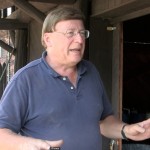
Dr. Starbuck explains that what we are about to tour is the most extensive excavation of the French and Indian War done by a college. He stresses the importance of SUNY Adirondack’s ongoing support of research at Fort William Henry and his excitement toward the attention, discovery and participation that the project has garnered.
As we walk from the Cemetery Building to our first stop, we step over grass, crushed stone and dirt. The tall brown walls of the Fort quickly assume our view of the landscape and cast a large shadow as we approach a back entrance. Outside the dwarfed doorway is a Redcoat Soldier.
“Looks good for his age,” Starbuck jokes, nodding his head toward the older historical actor. Everybody smiles but doesn’t pay too much attention to the man because we are too excited to enter the Fort.
“The funny thing about archeology,” Starbuck comments, “Is that there aren’t a lot of jobs, but everybody finds it interesting.” According to him, a career in archeological research is difficult to sustain so many interested people do it as a hobby. In fact, the majority of dig participants are volunteers, not students.
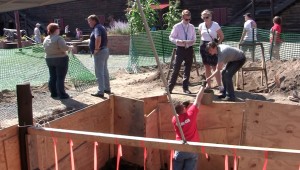 We finally arrived at the first site distinctively marked by a bright blue tent against the dark brown wall.
We finally arrived at the first site distinctively marked by a bright blue tent against the dark brown wall.
The pit is about 10 feet by 15 feet wide and five or six feet deep. The walls are reinforced with plywood and pieces of the brown timber used to construct the Fort’s massive walls. Around the outside of the hole is a pile of dirt and a large wooden tool we later learn is a sifter. At the far end of the area lays a couple lunch boxes, stacked buckets, paintbrushes and other tools.
Emily steps to the right of the area and begins talking to Dr. Starbuck about this site. Megan walks over to the pile of soil and inspects the sifting tool while I peer into the ditch.
Inside the pit is a man wearing a bright red shirt. Like every other worker, his forehead is glistened by sweat from the long day. Aaron bends down and sweeps dirt into a grey gallon bucket. He stands up to lift the now-full bucket about 5 feet up to Victoria who empties its contents into a sifter. She filters the soil from larger items—rocks, bones, teeth and nails—and puts the items into an envelope. The process is sluggish and watching the pair tediously work together proves the level of dedication each volunteer and student actually has to be a part of Dr. Starbuck’s team.
Sweeping the dirt is Aaron Whorf. He is an Army veteran who, following his honorable service and a 13-month deployment, decided to attend Plattsburgh State College to major in Criminal Justice/Sociology. Aaron says he enjoys archeology—he made it his minor—and our visit was during his first two-week session with Dr. Starbuck’s team.
Aaron is earning three credits through his work with the program which he will transfer to Plattsburgh. And if he chose, Aaron could have attended a second session to maximize Adirondack Community College’s six available credits for the course.
Dr. Starbuck interjects in my conversation with Aaron to pride his hard work. In fact, Starbuck explains, volunteers with a military background are not uncommon. They’re reliable and hard-working.
“I’ve had colonials digging,” Starbuck says, although he later jokes that those ranks are a bit more difficult to boss around.
The student on the surface sifting through the soil is Victoria Hafner. She pulls back her short hair and wipes her hands as she explains that she is a senior Anthropology student at SUNY Geneseo. Victoria is also part of Dr. Starbuck’s team to earn credit and gain valuable experience.
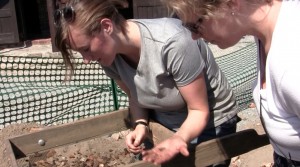 Like Dr. Starbuck some forty years ago, Victoria recognizes the need to gain firsthand work in archeology. Starbuck joined UAlbany’s archeological program when he was in the same position that Victoria is in now. He says that he needed to see a dig, experience the long days and become part of a team. Starbuck notes the feeling of not finding a single artifact for days but maintaining a certain level of optimism to continue the team’s mission. And that, he says, is a make-or-break experience.
Like Dr. Starbuck some forty years ago, Victoria recognizes the need to gain firsthand work in archeology. Starbuck joined UAlbany’s archeological program when he was in the same position that Victoria is in now. He says that he needed to see a dig, experience the long days and become part of a team. Starbuck notes the feeling of not finding a single artifact for days but maintaining a certain level of optimism to continue the team’s mission. And that, he says, is a make-or-break experience.
Aaron and Victoria are currently working in one of the Fort’s fireplaces. They find a variety of items that paint a picture of everyday life of the soldiers who once inhabited the camp.
“What were the privates doing for 360 days a year?” Starbuck remarks, highlighting the importance of solider life aside from battle.
The team has unearthed every indication of that life: Hundreds of pieces of glass from a broken window; animal teeth and bones; ceramics; mortar bomb fragments; lead musket balls of various sizes; buttons from soldiers’ uniforms; nails used to hold structures together and much, much more.
The most interesting discovery while we watched the students unearth history was a large bone fragment from an animal. It’s a simple find, but Dr. Starbuck’s forty-plus years of experience allow him to look below the surface. He explains that the bones and other animals parts in this fire pit indicate that the soldiers were eating fresh food—a sign of good times.
After touring the fireplace excavation, Dr. Starbuck leads our group outside of the Fort where a slighter larger team is digging a portion of a huge dump where soldiers disposed of their unwanted items.
Our group walks through a dark corridor labeled “Recruiting”. Appropriately enough, there is a young actor sitting at a table. He wears the entire colonial getup, from his hat to his boots. The actor isn’t past twenty years old and lets out a strong British accent as a child is forcefully guided into the ally by his father.
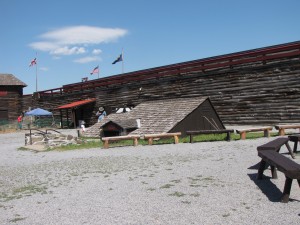 “Who’s my next victim?” the soldier says loudly, knowing that the context of his words won’t affect the genuine impression of the child.
“Who’s my next victim?” the soldier says loudly, knowing that the context of his words won’t affect the genuine impression of the child.
The child approaches the soldier as Dr. Starbuck leads us beyond the table and heads toward a humongous door about twenty feet ahead. The hall progressively lacks light as we near the door with the exception of a single ray of light streaming through a crack at the door’s massive hinges.
Unimpressed, Starbuck thrusts the entryway open and light instantly fills the corridor. He walks three steps outside the door and stands on an area of brown dirt, dried from baking in the sun all day. Tall grass surrounding the patch continues to the walls of the Fort and is interrupted only by roped-off pits where students can be seen digging. The ground sharply becomes a long slope just a few feet after the tall wall, highlighting the Fort’s strategic positioning.
Dr. Starbuck explains to us that behind him is where they have unearthed some great treasures. In fact, the team has concentrated on one area and is looking to expand a particular pit because they have had so much success.
Dr. Starbuck introduces us to three more team members. They are all sitting around a single board of plywood; two of them under the white tent to avoid the sun while the third is covered head-to-toe by lightly-colored clothing to repel its rays. The platform is leveled off by using a white bucket to account for the drastic angle of the sloped ground.
The workers have laid out on the plywood their recent finds: bones, nails and metal rings. Brown paper bags are covered in neatly-scribed pencil identifying each bag’s contents and a clipboard is positioned to log in any major finds.
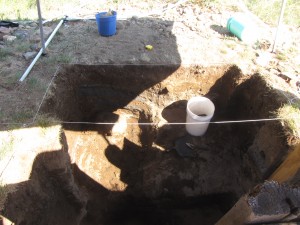 Dr. Starbuck explains the process for logging in discoveries. “You’d think by watching movies that every little piece needs to be logged for its location—that we could place every artifact back exactly where we found it.” That’s simply not true, but he finishes the point noting that, “If we find buttons lined up,” then that location would be recorded, as they suggest they’re from a soldier’s coat.
Dr. Starbuck explains the process for logging in discoveries. “You’d think by watching movies that every little piece needs to be logged for its location—that we could place every artifact back exactly where we found it.” That’s simply not true, but he finishes the point noting that, “If we find buttons lined up,” then that location would be recorded, as they suggest they’re from a soldier’s coat.
Following a salutary conversation between our group and Dr. Starbuck, we filed out of Fort William Henry through the Recruitment corridor and past the flogging post to trek back to Albany.
And as we felt that our trip was of utter discovery, it was only a glimpse into Adirondack Community College’s outstanding contributions to archeology in the North Country and Dr. Starbuck’s continued research with SUNY students.
Thank you to Dr. Starbuck, Victoria, Aaron, Betty, and SUNY Adirondack for welcoming us to Fort William Henry to learn and observe this program.


